Accepted Scientific Name: Echinocactus platyacanthus Link & Otto
Verh. Vereins Beford. Gartenbaues Konigl. Preuss. Staaten 3: 423. T. 14. 1826 (1827)
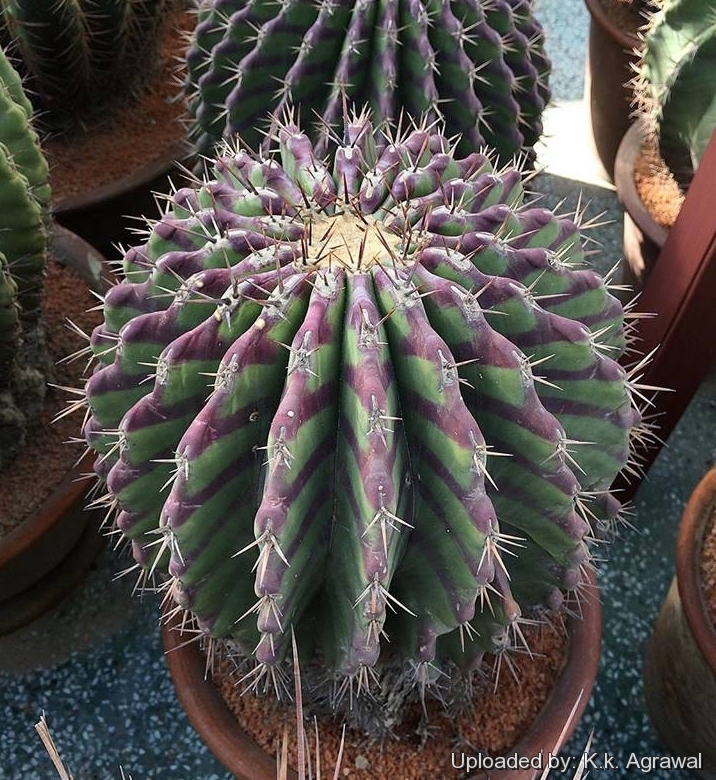
Echinocactus platyacanthus f. grandis Photo by: K.k. Agrawal
Origin and Habitat: Hills near Tehuacán, Puebla, Mexico.
Altutude range: Around 1600 metres above sea level.
Habitat: Limestone hills of Puebla, Mexico. This is one of the very large species of Echinocactus and is very characteristic of the deserts of Puebla where it is often the most conspicuous plant of the landscape. Accompanying cactus species can be Mammillaria conspicua and Mammillaria viperina.
Synonyms:
See all synonyms of Echinocactus platyacanthus
back
Accepted name in llifle Database:Echinocactus platyacanthus Link & OttoVerh. Vereins Beford. Gartenbaues Konigl. Preuss. Staaten 3: 423. T. 14. 1826 (1827)Synonymy: 22
back
Common Names include:
ENGLISH: Large Barrel Cactus, Giant Viznaga (USA), Giant Barrel Cactus, Giant Biznaga
SPANISH (Español): Biznaga de Dulce, Biznaga Gigante, Biznaga burra, Biznaga de Acitrón
Description: Echinocactus platyacanthusSN|10388]]SN|10367]] f. grandis (a.k.a. Echinocactus grandisSN|10367]]SN|10388]] Rose), often mentioned in older literature and sometimes offered in seed lists, should be fully synonymized with Echinocactus platyacanthusSN|10388]]SN|10367]], and the two plants are not readily distinguishable, if not for the geographical provenance ( Hills near Tehuacán, Puebla, Mexico).
Following is reported the description of Echinocactus grandisSN|10367]]SN|10388]] by N. L. BRITTON and J. N. ROSE (THE CACTACEAE Descriptions and Illustrations of Plants of the Cactus Family The Carnegie Institution of Washington - Washington, Volume III - pag 171 1922).
Stem: Simple, large, cylindric, to 2 meters high, 6 to 10 dm in diameter, dull green and, when young, with broad (purple) horizontal bands, very woolly at the crown.
Risbs: on young plants as few as 8, broad, high, and more or less undulate, but in old plants very numerous and rather thin.
Areoles: Remote on young plants, confluent in old flowering plants.
Spines: Stout, subulate, distinctly banded, especially the stouter ones, at first yellowish but soon reddish brown; radial spines usually 5 or 6, to 4 cm long, central spine solitary, 4 to 5 cm. long, straight.
Flowers: Numerous, yellow, 4 to 5 cm. long; scales on the ovary linear, their axils bearing an abundance of wool covering the ovary with a dense felty mass; upper scales narrow, rigid, more or less spiny tipped; outer perianth segments ovate, longapiculate, with ciliate margins; inner segments oblong, obtuse, retuse or apiculate, serrulate.
Fruit: Hidden in amass of soft white wool, oblong, 4 to 5 cm long.
Seeds: black, shining, 2.5 cm. long.
Remarks: It (and all the barrel cacti) consists almost entirely of a very wide cortex - the pith is narrow and the wood (vascular bundle) is very thin. Many non-cactus succulents have very broad shoots like this, but those are invariably due to a large amount of parenchymatous wood.
Subspecies, varieties, forms and cultivars of plants belonging to the Echinocactus platyacanthus group
Notes: The juvenile Echinocactus look very different from the mature specimens. In fact like the other Echinocactus and Ferocactus seedlings, the rib structure is not yet apparent, and they have pronounced tubercles.
Older specimens take on an oblong shape with age and can dominate a landscape because of their large size and impressive bulk. They also tend to lean to the south or southwest so that the spines can better protect the body of the plant from the harsh desert sun. In fact, desert travellers can use the plant as a compass.
Bibliography: Major references and further lectures:
1) THE CACTACEAE Descriptions and Illustrations of Plants of the Cactus Family By: N. L. BRITTON and J. N. ROSE The Carnegie Institution of Washington - Washington, Volume III - pag 171 1922.
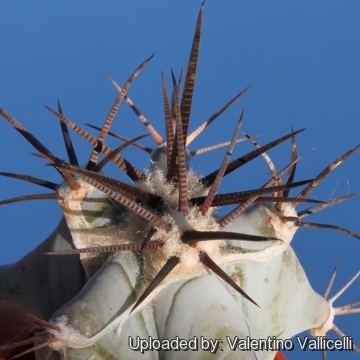 Young specimen (about 4 cm in diameter) Photo by: Valentino Vallicelli
Young specimen (about 4 cm in diameter) Photo by: Valentino Vallicelli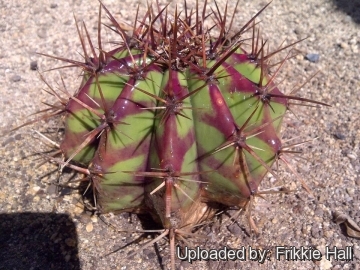 Echinocactus Ingens var. Grandis with its new set of purple lines. Photo by: Frikkie Hall
Echinocactus Ingens var. Grandis with its new set of purple lines. Photo by: Frikkie Hall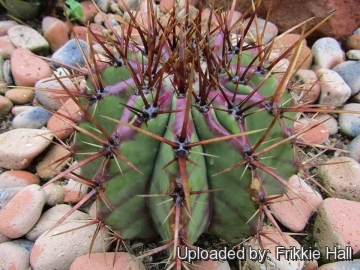 Echinocactus platyacanthus f. grandis Photo by: Frikkie Hall
Echinocactus platyacanthus f. grandis Photo by: Frikkie Hall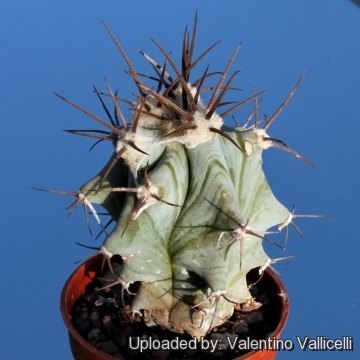 Echinocactus platyacanthus f. grandis Photo by: Valentino Vallicelli
Echinocactus platyacanthus f. grandis Photo by: Valentino Vallicelli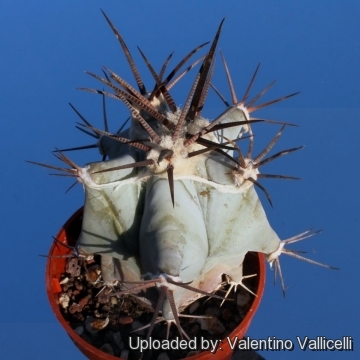 - A juvenile specimen (FO 35 Collector: Felipe Otero. Locality: Tehuacan, Puebla, Mexico) Photo by: Valentino Vallicelli
- A juvenile specimen (FO 35 Collector: Felipe Otero. Locality: Tehuacan, Puebla, Mexico) Photo by: Valentino VallicelliSend a photo of this plant.The gallery now contains thousands of pictures, however it is possible to do even more. We are, of course, seeking photos of species not yet shown in the gallery but not only that, we are also looking for better pictures than those already present.
Read More... Cultivation and Propagation: Frost tender but resistant to -4°C for short periods; Cold hardiness increases with improved drainage, so keep plants as dry as possible in winter. They grow best in well-drained soil and a position in full sun, which will help to maintain the lustre of the spines and longevity of the flowers. Provide the plant with extremely well-drained soils, as the plant are subject to crown and soft rot if it remains too moist. Besides, it performs wonderfully in containers, Container media should be coarse as well. Young plants are prone to mealy bug and red spider mite.
Reproduction: Propagate from seed.
Uses:: This plants is used to prepare a traditional candy, the pith is boiled with sugar to produce a popular sweet called “dulce de biznaga” or "acitrón". In this case the overcollection of wild plant for making cactus candy is the major threat to the survival of this species.
This plants were also used by indigenous peoples of Mexico in many manner, for example the woolly hairs this plant produces have been used as filling fibres and weaving.
















